Archived Storm Damage Blog Posts
Four Types of Storm Damage: 1. Hail
2/17/2021 (Permalink)
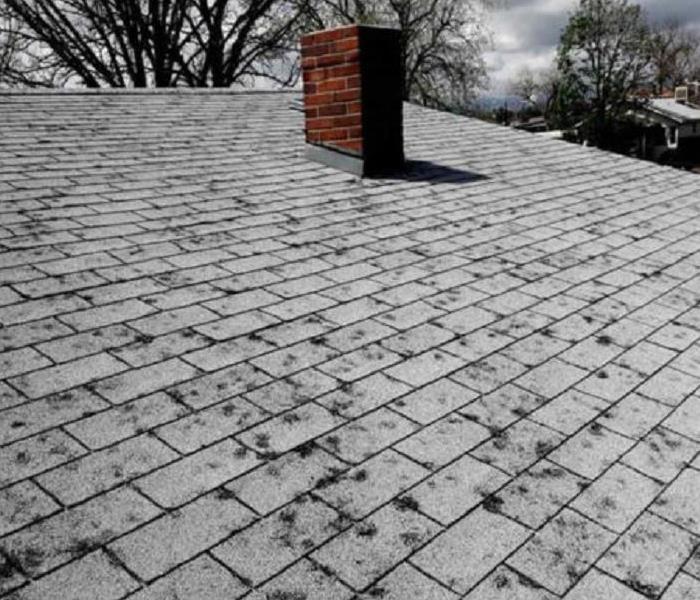 Hail Damage to Roof
Hail Damage to Roof
Storm Damage takes on different forms and is a threat to the homeowner and their abode. Where you live and the type of climate in your region of the country will determine the types of storms you are most likely to see. Blizzards are more prevalent in the Northeast, while tornadoes are more prevalent in the Mid-West. That being said, southeast Texas is in the midst of a severe winter storm with cold temperatures to match. This rare weather event has been described as a once in 100 year event. As of the date of this blog (2/17/21), over 4 million Texans in the southeastern part of the state are without power due to this winter weather event.
Growing up in the Phila region and residing in that area for most of my life, tornadoes were a threat, but only on a rare occasion. When I moved to Nashville, TN in 2009, tornado warnings and watches were a frequent occurrence during tornado season. Recorded data since 1995 shows that the Greater Nashville area averages 30 tornadoes a year. Scary to say the least.
Should your home be in the direct path of a tornado, there is a good likelihood that your home will not survive the event. However, damage could occur even if you are not in the direct path, or should a warning or watch be in your immediate area. Lightning storms typically precede a tornado event, and in many cases, these storms produce hail. Hail can cause severe damage due to the size, force and volume of hail stones coming down on the home.
The most notable forms of damage from hail are roof, siding and window damage. Hail can penetrate roofing materials and sheathing and can also break window glass and dent or crack siding materials.
Noted below are the four (4) major types of storm damage and are categorized as follows:
1) Hail
Hail is a form of solid precipitation & consists of balls or irregular lumps of ice. Hailstones usually measure between 0.2 in. & 6 in. in diameter.
Hailstones generally fall at higher speeds as they grow in size, though complicating factors such as melting, friction with air, wind, & interaction with rain & other hailstones can slow their descent through the Earth's atmosphere.
Severe damage to homes can occur to the roof, siding and windows.
2) Wind
3) Impact
4) Water
The other three will be discussed in future blogs, so stay tuned...
Four Types of Storm Damage: 2. Wind
2/17/2021 (Permalink)
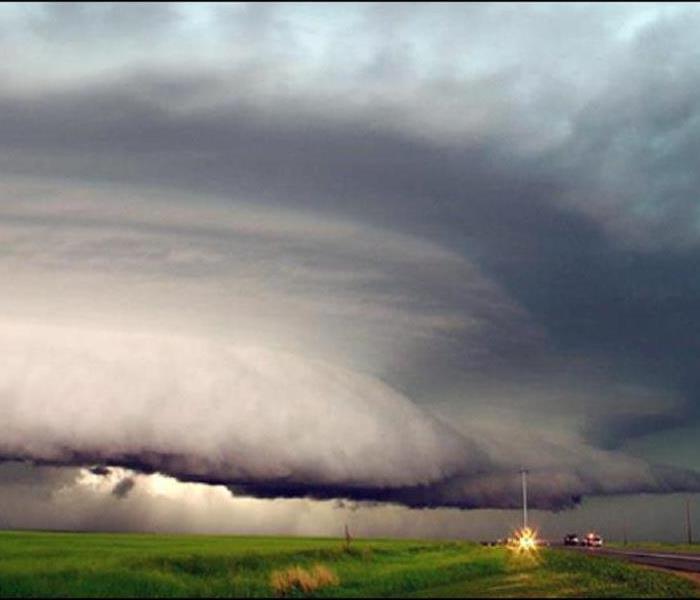 Thunderstorm
Thunderstorm
Noted below are the four (4) major types of storm damage and are categorized as follows:
1) Hail
2) Wind
Part 1 of our Storm Damage blog focused on Hail. Today's blog is going to focus on wind, one of the most destructive types of storm damage.
Wind force is defined in eight (8) different types by The National Severe Storms Laboratory (NSSL).
1) Straight-line wind: Thunderstorm wind not associated by rotation.
2) Downdraft: Small-scale column of air that rapidly sinks toward the ground.
3) Macroburst: An outward burst of strong winds at or near the surface with horizontal dimensions larger than 2.5 miles and occurs when a strong downdraft reaches the surface.
4) Microburst: Small concentrated downburst that produces an outward burst of strong winds at or near the surface.
5) Downburst: General term for all localized strong wind events that are caused by a strong downdraft within a thunderstorm.
6) Gust Front: Leading edge of rain-cooled air that clashes with warmer thunderstorm inflow.
7) Derecho: Widespread, long-lived wind storm that is associated with a band of rapidly moving showers or thunderstorms.
8) Haboob: Wall of dust that is pushed out along the ground from a thunderstorm downdraft at high speeds.
As can be seen, wind storms can come in a variety of ways, all with the ability to cause damage to person and property.
The most notable forms of damage from wind are roofing and siding blowing off the home, leaving the home defenseless against water or snow penetration.
3) Impact
4) Water
Impact and Water damage will be discussed in future blogs, so stay tuned...
Four Types of Storm Damage: 3. Impact
2/17/2021 (Permalink)
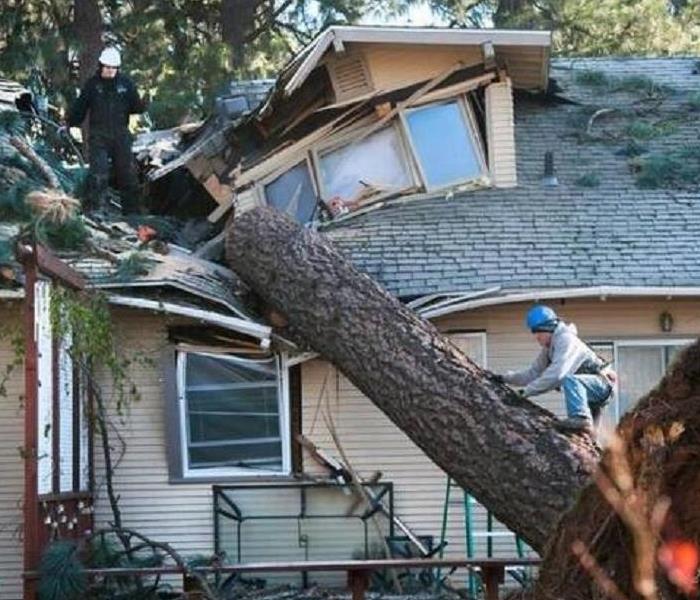 Tree Damage
Tree Damage
Noted below are the four (4) major types of storm damage and are categorized as follows:
1) Hail
2) Wind
3) Impact
Part 1 of our Storm Damage blog focused on Hail, Part 2 on Wind, today's blog is going to focus on Impact and the damages impact can have on the home.
Impact damage is the result of damage to the home or property as a result of an object landing, falling or being thrust into your home.
One example of this would be a tree being uprooted by heavy winds and landing on your roof, potentially ripping a hole into your home and even the ability to damage the stability of the structure itself.
Another example would be strong winds blowing over a picnic table/chair on your patio or deck and striking your window or door.
When we think of tornadoes, we think of ultimate destruction. As true as that is, many homes are damaged through impalement whereby building materials, tree limbs and other materials are blown into a home.
4) Water
Water damage is the final type of storm damage to be discussed in this series, so stay tuned...
Four Types of Storm Damage: 4. Water
2/17/2021 (Permalink)
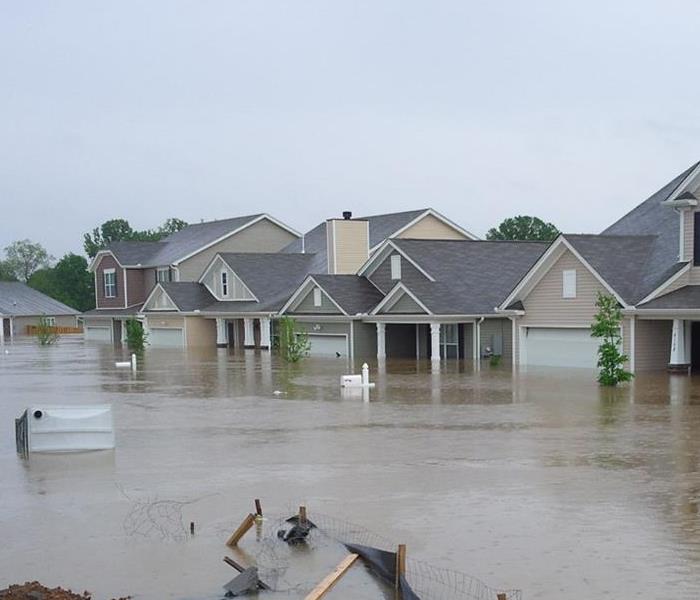 Flood Damage
Flood Damage
Noted below are the four (4) major types of storm damage and are categorized as follows:
1) Hail
2) Wind
3) Impact
4) Water
Water Damage is the last blog in our series of types of storm damage.
Water damage from storms comes in many forms. Blizzards can produce large amounts of snow along with snow drifts from heavy winds. Snow then can get piled into a corner of a roof or home, and as it melts, runs into the home, through the attic or walls and even around windows and doors.
Tornadoes are usually preceded by thunderstorms and heavy rainfall. With fierce winds, rain can be pushed into the home from unusual angles, sometimes penetrating areas of the home not protected by flashing.
Hurricanes produce heavy rainfall and large volumes of water of which cause flooding, especially in low lying areas and areas close by to rivers and seas.
Besides the physical damage to home and property, the after effects of water damage are mold. In the booklet "Mold & Mildew In Your Flood Damaged Home," produced by FEMA, "Mold growths, or colonies, can start to grow on a damp surface within 24 to 48 hours." This is a whole other problem you now have to deal with and in many instances, is hidden behind the sheetrock in walls and ceilings, or even flooring material.
Storm damage takes on different forms, but one thing they all have in common is that they can and will cause damage to your home and property. Preparing for a catastrophic event like a storm is difficult. Storm shutters, hurricane windows, metal roofing and fiber cement siding are some ways to help protect your home against storm damage. But when a 100 year flood or snow storm hit, expect damage.
Should the need arise for help after an event like this, SERVPRO of Derry/Londonderry is there to mitigate the damage and make it "Like it never even happened."®
Who's Knocking At Your Door
2/26/2020 (Permalink)
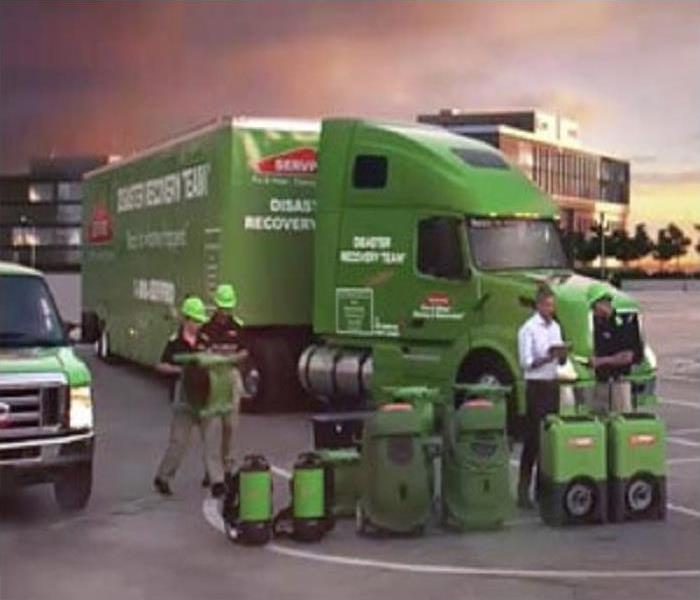 SERVPRO Storm Response Team
SERVPRO Storm Response Team
After a flood disaster, expect multiple visitors who will want to help you recover. No matter who’s knocking, always ask for identification and the purpose of the visit. Never give out personal information such as your Social Security or bank account number. Government officials will never ask for money and you should never pay for their service.
GOVERNMENT
If you apply for federal disaster assistance, a FEMA inspector may call and visit to assess your property damage. They will have a FEMA ID badge.
- Local Building, Permitting, & Government Official
Officials inspect damaged buildings to determine if they can be occupied. If they have damage, officials (state/county/local) may visit to gather damage data in the weeks and months after an event to inspect and collect information. They should have an ID badge from their agency.
INSURANCE
- Homeowners Insurance Adjuster
If you file a claim with your homeowners insurance, a homeowners insurance adjuster will call and visit to assess non-flood damage. They should have a state-issued agency license or ID.
If you have filed an NFIP policy claim, you will receive a call and a visit from a flood insurance adjuster. They will collect information, take photos, and help fill out claims paperwork. They will have a Flood Adjuster Certification Card and picture ID.
OTHER
Third-party certified public adjusters may offer help to inspect damaged homes and help you file claims for insurance, grants, and loans, but be cautious. There is usually a fee of 10% to 30% of your total settlement. Be sure to ask for credentials.
- Contractors and Other Repairers
Be cautious if a contractor or other repair professional approaches you directly and unsolicited. Ask for IDs, licenses, proof of insurance, and references. Do not pay for all repairs up front, though legitimate contractors may request a percentage of their fees to begin work. Obtain a contract with both labor and cost estimates.
No fees should be charged for the inspections performed by government or NFIP representatives. Social Security and bank account numbers are never required by inspectors or adjusters. Always safeguard your personal information, and when in doubt, don’t give out information.
The OTHER category is where you need to be cautious and to make sure that you are dealing with a reputable company/business. Perform your due diligence and do not provide personal information unless you are absolutely certain that it will be safe and secure.
SERVPRO has been in business since 1967 and has a stellar reputation for serving their customers with honesty and integrity. SERVPRO will make it "Like it never even happened."
Resource: IICRC.
SERVPRO of Derry/Londonderry is an IICRC certified water and fire damage restoration company.
Unlikely Suspects: Fire & Ice
2/25/2020 (Permalink)
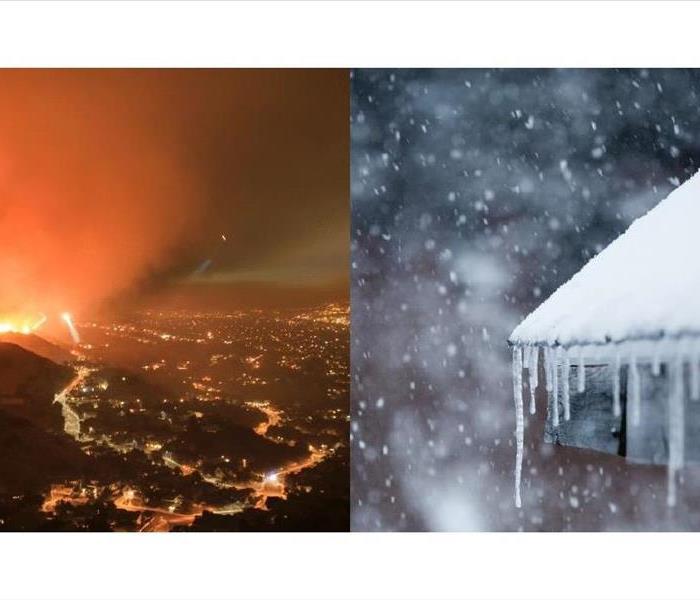 Wildfire & Snow Covered Roof
Wildfire & Snow Covered Roof
When discussing the risk of floods in the U.S., many assume coastal states face the greatest risk. However, according to Ray Farmer, National Association of Insurance Commissioners (NAIC) President and Director of the South Carolina Department of Insurance (SCDOI), states affected by other natural disasters, such as wildfires and winter storms, are often just as vulnerable.
“Awareness is a critical step in prevention,” said Director Farmer. “Homeowners should carefully evaluate environmental conditions and invest the time and money necessary to reduce their risk, preventing catastrophic damage before it happens.”
In the wake of raging forest fires, western areas of the U.S. are left vulnerable to mudflows and flood conditions. Additionally, areas prone to harsh winter storms also face an elevated and often unexpected risk of flood conditions. Ice dams and snowmelt can cause flash floods, which are generally not covered by regular homeowners insurance policies, and hailstorms can cause roof damage, leaving homes susceptible in the event of heavy rain.
Mitigating risk of flooding, fires, storms and other weather events can be accomplished by keeping your roof in good repair; trimming trees away and removing any weakened sections that might break off and fall onto buildings; and maintaining defensible space around your home. To protect property from ice dams:
- Keep drains, gutters and downspouts free of debris to promote proper flow.
- Relocate heat sources that are installed in open attic areas that are directly under the roof.
- Insulate and seal attic penetrations such as vents.
- Install heating cables on eaves, gutters and downspouts or around flat roofs. This will create effective channels to allow water to drain safely.
Take these steps to help protect the life you have worked hard to build.
Winter Snowstorms
2/25/2020 (Permalink)
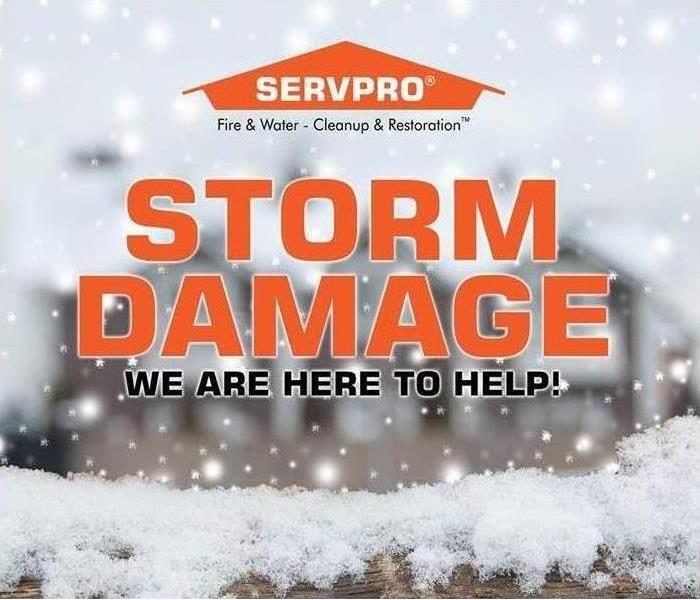 SERVPRO Winter Storm Damage Service
SERVPRO Winter Storm Damage Service
Winter storms create a higher risk of car accidents, hypothermia, frostbite, carbon monoxide poisoning, and heart attacks from overexertion. Winter storms and blizzards can bring extreme cold, freezing rain, snow, ice, and high winds. A winter storm can:
- Last a few hours or several days;
- Knock out heat, power, and communication services; and
- Place older adults, young children, and sick individuals at greater risk.
IF YOU ARE UNDER A WINTER STORM WARNING, FIND SHELTER RIGHT AWAY
- Stay off roads.
- Stay indoors and dress warmly.
- Prepare for power outages.
- Use generators outside only and away from windows.
- Listen for emergency information and alerts.
- Look for signs of hypothermia and frostbite.
- Check on neighbors.
HOW TO STAY SAFE WHEN A WINTER STORM THREATENS:
Prepare NOW
- Know your area’s risk for winter storms. Extreme winter weather can leave communities without utilities or other services for long periods of time.
- Prepare your home to keep out the cold with insulation, caulking, and weather stripping. Learn how to keep pipes from freezing. Install and test smoke alarms and carbon monoxide detectors with battery backups.
- Pay attention to weather reports and warnings of freezing weather and winter storms. Sign up for your community’s warning system. The Emergency Alert System (EAS) and National Oceanic and Atmospheric Administration (NOAA) Weather Radio also provide emergency alerts.
- Gather supplies in case you need to stay home for several days without power. Keep in mind each person’s specific needs, including medication. Do not forget the needs of pets. Have extra batteries for radios and flashlights.
- Create an emergency supply kit for your car. Include jumper cables, sand, a flashlight, warm clothes, blankets, bottled water, and non-perishable snacks. Keep the gas tank full.
- Learn the signs of, and basic treatments for, frostbite and hypothermia.
Survive DURING
- Stay off roads if at all possible. If trapped in your car, then stay inside.
- Limit your time outside. If you need to go outside, then wear layers of warm clothing. Watch for signs of frostbite and hypothermia.
- Avoid carbon monoxide poisoning. Only use generators and grills outdoors and away from windows. Never heat your home with a gas stovetop or oven.
- Reduce the risk of a heart attack. Avoid overexertion when shoveling snow.
- Watch for signs of frostbite and hypothermia and begin treatment right away.
- Check on neighbors. Older adults and young children are more at risk in extreme cold.
RECOGNIZE AND RESPOND
- Frostbite causes loss of feeling and color around the face, fingers, and toes.
- Signs: Numbness, white or grayish-yellow skin, firm or waxy skin
- Actions: Go to a warm room. Soak in warm water. Use body heat to warm. Do not massage or use a heating pad.
- Hypothermia is an unusually low body temperature. A temperature below 95 degrees is an emergency.
- Signs: Shivering, exhaustion, confusion, fumbling hands, memory loss, slurred speech, or drowsiness
- Actions: Go to a warm room. Warm the center of the body first—chest, neck, head, and groin. Keep dry and wrapped up in warm blankets, including the head and neck.
Resource: Dept of Homeland Security
Snow Loads
12/13/2019 (Permalink)
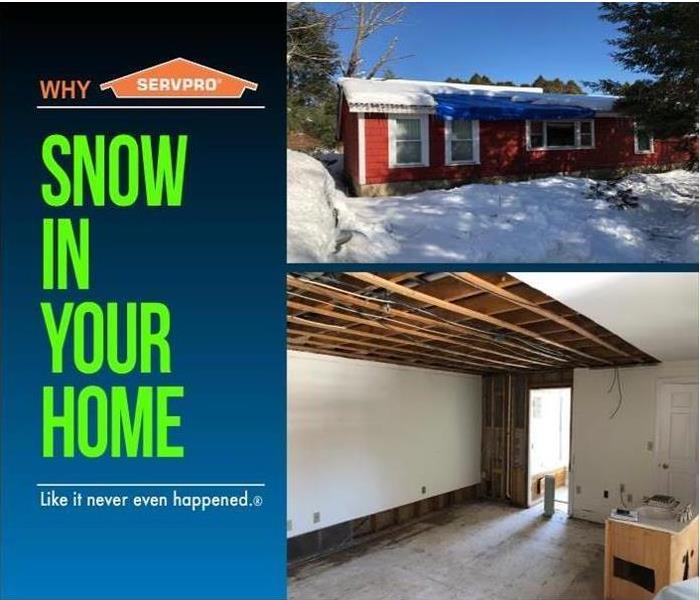 Snow Load on Roof
Snow Load on Roof
FEMA has a great source (Snow Load Safety Guide 2013) for determining what would be considered a safe snow load on your roof. It was designed for pretty much anyone responsible for safety and maintenance of a home or building.
A snow load is the amount of snow on your roof top. The load is not necessarily determined by one event, but by as many events as occur whereby the snow load accumulates.
The weight of snow is not measurable by the number of inches, but by the moisture content within the snow itself. If you have 1" of dry snow, the weight of that 1" would be approximately 3 lbs per sq ft, where as 1" of a wet snow may weigh approximately 21 lbs per sq ft. On the other hand, an ice storm event may raise that 1" accumulation to 57 lbs per sq ft. Considerable differences.
One major concern of a snow load is the weight exceeding the structural capacity. Drifting or the sliding of snow to specific areas of your roof could increase the risk of damage through accumulated weight.
How do you prevent this from becoming an issue? Snow removal. If you don't have one, get yourself a roof shovel or roof rake. Takes some effort, but is an effective, preventive tool and measure worth taking.

 24/7 Emergency Service
24/7 Emergency Service







